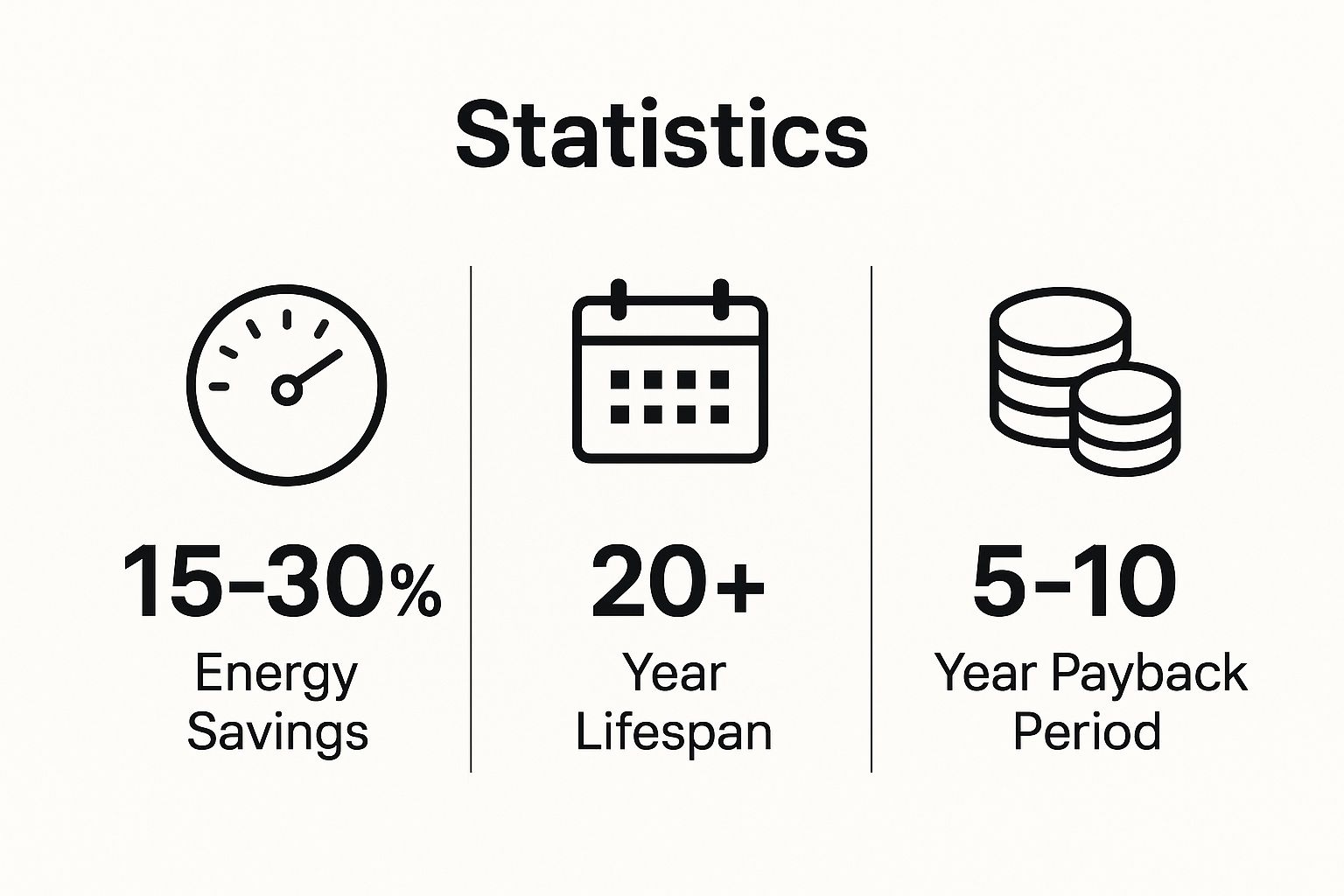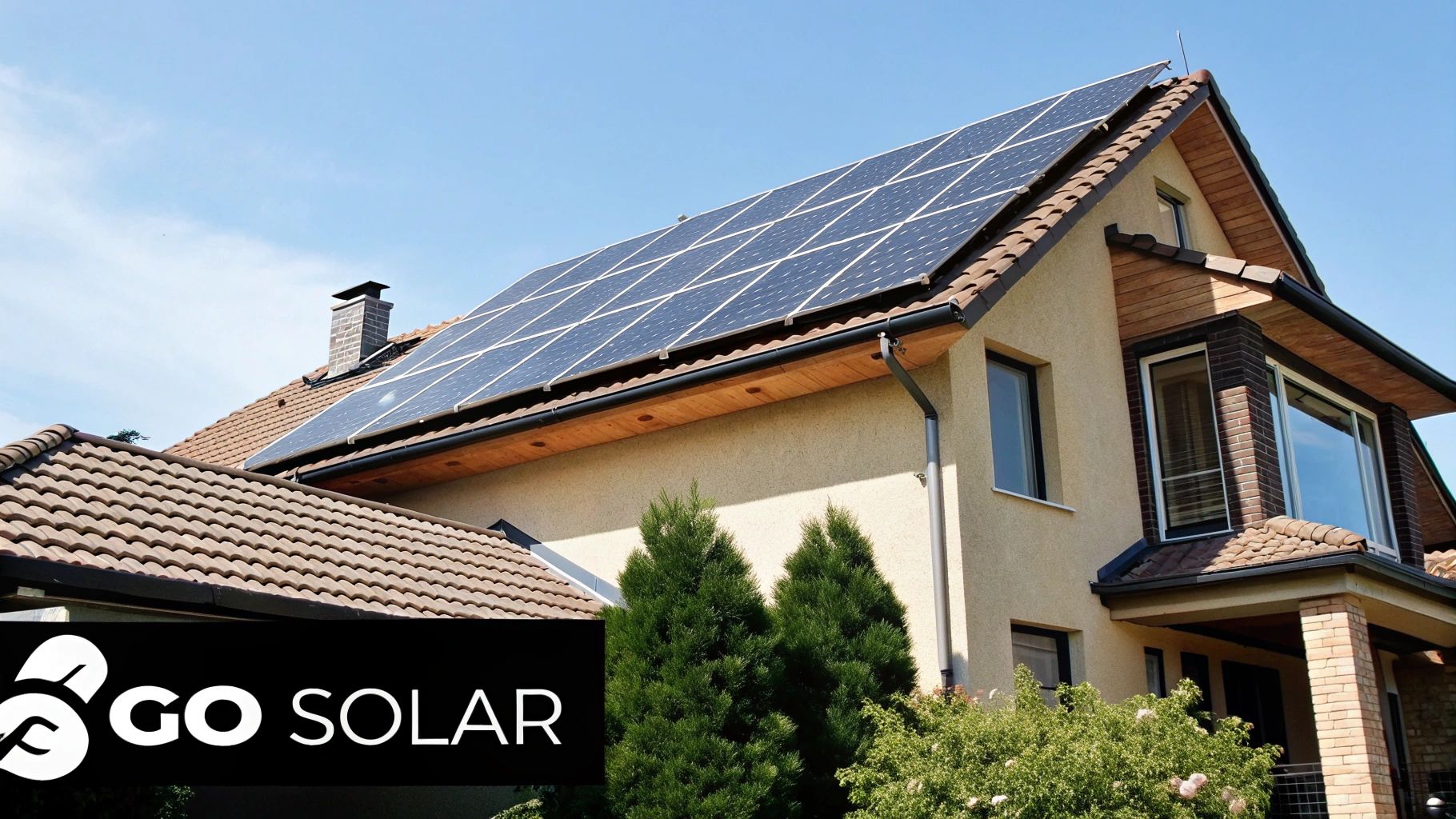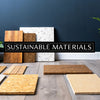Your 2025 Green Renovation Checklist: 8 Essential Upgrades

Renovating your home presents a unique opportunity to not only refresh your space but also to make a positive impact on the environment and your long-term living costs. A thoughtfully planned green renovation moves beyond simple aesthetics, focusing instead on creating a healthier, more sustainable, and highly efficient living environment. This guide serves as your comprehensive green renovation checklist, detailing eight critical areas where strategic upgrades can yield significant benefits.
From slashing your energy bills and conserving precious water to improving indoor air quality with non-toxic materials, each step is an investment in your property's value and our planet's future. By making conscious choices, you can significantly reduce your home's ecological footprint.
We'll explore practical, actionable insights, covering everything from selecting high-performance insulation and windows to integrating renewable energy and sustainable finishes. This checklist is designed to empower every New Zealand and Australian homeowner to build a smarter, greener home. Let's begin the journey toward a more sustainable living space, one conscious renovation decision at a time.
1. Energy-Efficient Insulation Installation: The Unseen Hero of Home Comfort
A truly effective green renovation starts not with what you see, but with what you don’t. Tucked away within your walls, ceilings, and floors, high-performance insulation is one of the most powerful tools in your green renovation checklist. Its primary role is to minimise heat transfer, creating a robust thermal barrier that keeps your home warmer in winter and cooler in summer.
Upgrading your insulation directly slashes your reliance on heating and cooling systems, which are often the largest energy consumers in a home. This involves more than just stuffing material into cavities; it requires a strategic approach. The goal is to create a complete, continuous thermal envelope, meticulously air-sealed to prevent costly draughts and energy loss through gaps and cracks.
Why It's a Green Renovation Essential
A well-insulated home is the foundation of energy efficiency and long-term sustainability. By focusing on materials with a high R-value (the measure of thermal resistance), you are making a fundamental upgrade that pays dividends for decades.
- Eco-Friendly Materials: Choose sustainable options like New Zealand sheep's wool, which is a natural, renewable fibre with excellent thermal and moisture-regulating properties. Other great choices include cellulose (made from recycled paper) or high-density fibreglass batts containing recycled content.
- Reduced Energy Consumption: By dramatically lowering the need for artificial heating and cooling, you reduce your home’s carbon footprint. This is a core principle seen in standards like the Passive House movement, where advanced insulation helps achieve up to a 90% reduction in heating and cooling energy usage.
- Enhanced Indoor Comfort: Proper insulation eliminates cold spots and draughts, creating a stable and comfortable indoor environment year-round, improving occupant wellbeing.
The following infographic highlights the tangible returns on investing in quality insulation.

These figures demonstrate that while insulation requires an initial investment, its long lifespan and significant energy savings provide a clear and compelling financial and environmental return.
2. Water-Efficient Fixtures and Systems: Conserving Every Drop
A critical, yet often overlooked, part of any green renovation checklist is the responsible management of water. Upgrading to water-efficient fixtures and systems is a powerful strategy to reduce your home's environmental footprint, conserve a precious resource, and lower your utility bills. This approach involves replacing outdated, high-consumption fittings with modern, low-flow alternatives that deliver excellent performance while using significantly less water.
The goal is to systematically reduce water consumption across your entire home, from the bathroom to the kitchen and garden. This means installing low-flow toilets, showerheads, and tapware, as well as choosing efficient appliances. For a more comprehensive system, advanced solutions like greywater recycling or rainwater harvesting can further diminish your reliance on the municipal supply.

Why It's a Green Renovation Essential
Integrating water conservation measures is fundamental to creating a truly sustainable and resilient home. By prioritising efficiency, you contribute to broader community water security and reduce the energy needed to treat and pump water to your property.
- Guaranteed Performance: Look for products with a high WELS (Water Efficiency Labelling Scheme) star rating. This New Zealand and Australian standard provides clear, at-a-glance information on water consumption and efficiency, ensuring you get performance without waste. A 4-star showerhead, for example, can save a family thousands of litres per year.
- Reduced Water and Energy Bills: Less water used means lower water bills. Crucially, it also means lower energy bills, as your water heater has less water to process. This dual saving accelerates the payback period for your investment.
- Drought Resilience: In regions facing water restrictions, having a water-efficient home provides resilience and ensures you can maintain a comfortable lifestyle while adhering to conservation mandates, as seen in areas like California where such upgrades are common practice.
The data above shows that, like insulation, investing in water-efficient fixtures offers a swift and significant return. The immediate reduction in utility costs makes it one of the most financially rewarding upgrades in a green renovation.
3. Sustainable Flooring Materials: The Foundation of a Healthy Home
The floor is one of the largest surfaces in any room, making your choice of material a critical component of a successful green renovation checklist. Sustainable flooring moves beyond just aesthetics, focusing on materials that are environmentally responsible, durable, non-toxic, and sourced from renewable or recycled origins. This choice directly impacts everything from your home's air quality to its long-term carbon footprint.
Selecting eco-friendly flooring involves looking at the entire life cycle of the product. This means considering how the raw materials are harvested, the energy used in manufacturing, the chemicals used in finishes, and its potential for reuse or recycling at the end of its life. The goal is to choose a surface that is both beautiful and beneficial for the planet and your family’s health.
Why It's a Green Renovation Essential
A thoughtfully chosen floor underpins the health and sustainability of your entire living space. By prioritising materials that are both renewable and low in toxicity, you create a foundation that is safe, resilient, and aligned with eco-conscious principles.
- Improved Indoor Air Quality: Many conventional flooring options, adhesives, and finishes release volatile organic compounds (VOCs), which can be harmful to respiratory health. Low-VOC and natural options like cork, bamboo, and reclaimed timber significantly reduce indoor air pollution.
- Renewable and Recycled Sources: Materials like cork (harvested from the bark of cork oak trees) and bamboo (a rapidly growing grass) are highly renewable. Options like reclaimed wood give a second life to valuable timber, preventing it from ending up in landfill and reducing the demand for virgin resources.
- Long-Term Durability: Sustainable does not mean delicate. High-quality, strand-woven bamboo, for instance, is harder than many traditional hardwoods, offering a lifespan of 50 years or more. This longevity reduces the need for replacement, saving resources and money over time. As one of our top sustainable interior design ideas for 2025, flooring is a great place to start.
4. LED Lighting and Smart Controls: Illuminating Efficiency and Ambiance
A key element of any modern green renovation checklist involves moving beyond the simple light bulb to a smarter, more efficient lighting system. Upgrading from outdated incandescent or fluorescent lights to Light Emitting Diodes (LEDs) combined with intelligent controls is a high-impact change. This dual approach tackles energy waste from two angles: using inherently more efficient technology and ensuring that light is only used when and where it's needed.
This strategy involves replacing every light source with a high-quality LED equivalent and integrating smart features like dimmers, occupancy sensors, and programmable schedules. The result is a dynamic lighting environment that adapts to your lifestyle, saves significant energy, and enhances the overall feel of your home. Landmark examples, like the Empire State Building's LED retrofit saving millions annually, prove the scalability and effectiveness of this technology.
Why It's a Green Renovation Essential
Intelligent lighting is a cornerstone of a truly sustainable home, offering a powerful combination of resource conservation, user convenience, and long-term cost savings. It represents a shift from passive energy consumption to active energy management.
- Dramatically Reduced Energy Use: ENERGY STAR certified LED bulbs use up to 90% less energy and last 25 times longer than traditional incandescent bulbs. Pairing them with occupancy sensors in areas like bathrooms and hallways can slash lighting energy costs even further.
- Enhanced Control and Wellbeing: Smart controls allow you to tailor your home’s lighting to suit any activity, from bright task lighting in the kitchen to warm, relaxing light in the living room. Advanced systems can even mimic natural daylight patterns, which supports a healthy circadian rhythm. These thoughtful details can elevate your lighting from purely functional to a central part of your green home decor.
- Reduced Waste and Maintenance: The exceptional lifespan of LEDs (often exceeding 25,000 hours) means fewer bulbs end up in landfills and significantly less time is spent on replacements, making it a "fit and forget" solution for many years.
5. Solar Panel Installation: Powering Your Home with the Sun
A cornerstone of any forward-thinking green renovation checklist is harnessing the power of the sun. Installing photovoltaic (PV) solar panels allows you to generate your own clean, renewable electricity directly on-site. This technology captures sunlight and converts it into usable power for your home, dramatically reducing your reliance on grid electricity generated from fossil fuels.

This process involves more than just attaching panels to your roof; it's about creating a self-sufficient energy system. Modern systems can be roof-mounted, ground-mounted, or even integrated directly into your building's structure, like Tesla's Solar Roof. The goal is to generate enough energy to offset your consumption, significantly lowering your carbon footprint and energy bills.
Why It's a Green Renovation Essential
A solar installation is a powerful, visible statement of your commitment to sustainability and energy independence. By producing your own clean energy, you are making a direct impact on reducing greenhouse gas emissions while future-proofing your home against rising electricity costs.
- Clean Energy Generation: Solar panels produce zero emissions during operation, providing a clean power source that directly reduces your household's environmental impact. This aligns with national efforts across New Zealand to transition towards 100% renewable energy generation.
- Reduced Energy Bills & Grid Independence: Generating your own electricity drastically lowers your monthly power bills. When paired with battery storage, you can store excess energy for use at night or during power outages, achieving a high degree of energy independence.
- Increased Property Value: Homes equipped with solar panel systems are increasingly sought after. This high-impact upgrade is a significant investment that adds tangible value and appeal to your property for eco-conscious buyers.
The following infographic highlights the tangible returns on investing in a solar PV system.
These figures show that while solar installation requires a significant initial outlay, its long lifespan and substantial energy savings deliver a strong financial and environmental return on investment.
6. High-Performance Windows and Doors: The Clear Choice for Efficiency
Windows and doors are more than just functional openings; they are critical components of your home's thermal envelope. Old, single-glazed windows or poorly sealed doors are notorious weak points, acting as thermal bridges that allow precious heated or cooled air to escape. Upgrading to high-performance units is a cornerstone of any serious green renovation checklist, directly impacting your home’s energy use and comfort.
This upgrade involves selecting windows and doors engineered for superior thermal performance. This means double or even triple-pane glazing, insulated frames made from materials like uPVC or thermally broken aluminium, and advanced low-emissivity (low-E) coatings. These coatings reflect infrared light, keeping heat out in summer and inside during winter, while proper sealing eliminates costly air leakage.
Why It's a Green Renovation Essential
Choosing the right windows and doors is a strategic investment that delivers immediate and long-term environmental and financial benefits. It’s an essential step in creating a high-performing, comfortable, and sustainable home.
- Drastic Energy Reduction: High-performance windows can significantly reduce heat loss in winter and heat gain in summer, lowering your reliance on heating and cooling systems. Projects adhering to Passive House standards, for example, often use triple-pane windows to help achieve up to a 90% reduction in heating and cooling energy.
- Superior Indoor Comfort: By minimising draughts and radiant heat transfer, these upgrades create a stable indoor temperature. This eliminates cold spots near windows in winter and reduces overheating from solar gain in summer, enhancing occupant wellbeing.
- Climate-Specific Design: Modern glazing options can be tailored to your specific climate. In cooler parts of New Zealand, a higher Solar Heat Gain Coefficient (SHGC) allows you to harness free warmth from the sun, while in warmer regions, a lower SHGC helps keep your home cool. Look for products with a high ENERGY STAR rating for proven performance.
7. Green Roof or Cool Roof Systems: Your Home's Living Canopy
A forward-thinking green renovation looks beyond the four walls and considers the roof as a critical asset for sustainability. Installing a green roof (a vegetated layer) or a cool roof (using highly reflective materials) transforms this often-overlooked surface into a powerful tool for environmental benefit. These systems directly combat the urban heat island effect, where dark, heat-absorbing surfaces raise city temperatures.
A green roof involves layering a waterproof membrane, drainage system, growing medium, and specially selected plants. A cool roof uses materials or coatings with high solar reflectance to bounce sunlight away, preventing the building from absorbing excess heat. Both solutions dramatically reduce the energy needed for cooling, a key component of any comprehensive green renovation checklist.
Why It's a Green Renovation Essential
Choosing a green or cool roof is a significant investment in your property's long-term performance and the health of your local environment. It's a highly visible statement of your commitment to innovative, sustainable design that delivers tangible results.
- Significant Energy Savings: Cool roofs can reduce a building's cooling energy needs by up to 20%, as seen in large-scale rollouts by retailers like Target. Green roofs offer similar benefits, with landmarks like the Chicago City Hall reporting significant reductions in annual energy costs.
- Stormwater Management: A green roof acts like a sponge, absorbing and filtering rainwater. This reduces runoff into municipal stormwater systems, preventing pollution and easing pressure on public infrastructure, a crucial benefit in urban areas.
- Extended Roof Lifespan: Both systems protect the underlying roof membrane from harsh UV radiation and extreme temperature fluctuations, which can more than double the roof's service life.
Choosing the right system for your property involves careful planning, but the environmental and financial rewards are substantial.
8. Non-Toxic Paint and Finishes: A Breath of Fresh Air for Your Home
One of the most impactful and accessible changes in a green renovation checklist is what you put on your walls. Traditional paints, stains, and finishes can release volatile organic compounds (VOCs) into the air for years after they have dried. These harmful chemicals degrade indoor air quality and contribute to health issues. Choosing non-toxic alternatives is a crucial step toward creating a healthier living environment.
Low- and zero-VOC paints are formulated to minimise or eliminate these harmful emissions without sacrificing performance, colour, or durability. This approach extends beyond just the topcoat; it involves a complete system of low-VOC primers, sealers, and finishes to ensure the entire surface is eco-friendly. This simple switch directly improves the air you breathe every day, making your home a safer sanctuary.
Why It's a Green Renovation Essential
A beautiful finish shouldn't come at the cost of your health or the planet. By prioritising non-toxic paints and finishes, you address a major source of indoor pollution and support a more sustainable industry.
- Improved Indoor Air Quality: The primary benefit is the significant reduction in airborne toxins. This is especially important for households with children, elderly members, or individuals with allergies and chemical sensitivities. Brands like AFM Safecoat cater specifically to this need.
- Reduced Environmental Impact: Low-VOC and natural paints use less petroleum-based solvents, lowering their carbon footprint. Plant-based and milk paints offer biodegradable options derived from renewable resources, aligning perfectly with sustainable principles.
- High-Performance and Durability: Modern eco-friendly paints, such as Benjamin Moore's Natura or Sherwin-Williams' ProGreen lines, offer excellent coverage, washability, and longevity, proving that green choices do not require a compromise on quality.
Many projects, from LEED Platinum buildings to health-conscious schools and hospitals, now mandate the use of zero-VOC paints, underscoring their importance in modern construction and renovation. You can explore a wide range of eco-friendly interior design tips on maakhome.co.nz to further guide your choices.
Green Renovation Checklist Comparison
| Item | Implementation Complexity 🔄 | Resource Requirements ⚡ | Expected Outcomes 📊 | Ideal Use Cases 💡 | Key Advantages ⭐ |
|---|---|---|---|---|---|
| Energy-Efficient Insulation Installation | Moderate: Requires professional installation, air sealing | High-quality eco-friendly insulation materials | Reduces heating/cooling costs by 15-30%, improves comfort | New builds, retrofits aiming for long-term energy savings | High R-value, long lifespan, reduces carbon footprint |
| Water-Efficient Fixtures and Systems | Moderate: Plumbing modifications and new tech adoption | Low-flow fixtures, smart sensors, greywater systems | Cuts water use by 20-40%, lowers bills, utility rebates | Residential, commercial buildings focusing on water savings | Significant water savings, rebates, modern designs |
| Sustainable Flooring Materials | Moderate: Some require special installation techniques | Renewable/recycled materials like bamboo, cork | Improves indoor air quality, durable 25-50 years | Eco-conscious interiors, areas seeking durability and aesthetics | Low-VOC, renewable, supports sustainable forestry |
| LED Lighting and Smart Controls | Low to moderate: Simple bulb replacement, smart integration | LED bulbs, sensors, programmable controls | Reduces lighting energy use by 75-90%, very long lifespan | Residential, commercial lighting upgrades for energy efficiency | High efficiency, minimal maintenance, smart features |
| Solar Panel Installation | High: Requires professional installation, roof prep | Photovoltaic panels, mounting, monitoring systems | Reduces or eliminates electricity bills, 6-10 year payback | Homes and businesses aiming for clean energy and independence | Large energy savings, tax credits, energy independence |
| High-Performance Windows and Doors | High: May need structural modifications and careful installation | Advanced glazing, insulated frames, sealing materials | Cuts heating/cooling costs by 10-25%, improves comfort | Renovations and new builds targeting energy efficiency | Improved comfort, noise reduction, security |
| Green Roof or Cool Roof Systems | High: Structural reinforcement and ongoing maintenance | Vegetation, waterproofing, reflective materials | Lowers cooling costs 10-30%, manages stormwater | Urban areas combating heat islands and stormwater management | Extends roof life, reduces urban heat, supports wildlife |
| Non-Toxic Paint and Finishes | Low to moderate: Standard painting with special products | Low/zero VOC paints, natural pigments | Improves indoor air quality, reduces pollutants | Interiors sensitive to air quality (schools, hospitals) | Healthier environments, low odor, environmentally friendly |
Your Blueprint for a Sustainable and Stylish Home
Embarking on a renovation project is a significant undertaking, but by integrating sustainability at every stage, you transform a simple upgrade into a lasting investment. The journey through this green renovation checklist has equipped you with a powerful framework for making smarter, more responsible choices. You've moved beyond abstract ideas to actionable strategies, from the foundational importance of high-performance insulation and double-glazed windows to the daily impact of water-efficient fixtures and LED lighting.
Each decision you've considered, whether installing solar panels to harness natural energy or opting for a cool roof to manage thermal gain, contributes to a bigger picture. Your home becomes more than just a structure; it evolves into a high-functioning ecosystem that actively reduces its environmental footprint. This isn't about sacrifice. It’s about intelligent design that enhances comfort, lowers your utility bills, and improves indoor air quality through non-toxic paints and finishes.
From Checklist to Lasting Change
The true power of this checklist lies not in ticking off boxes, but in adopting a mindset. The most impactful green renovation is one built on principles of durability, efficiency, and mindful consumption. You’ve learned to assess the entire lifecycle of a product, from its origins in sustainably managed forests for flooring to its end-of-life recyclability.
This approach champions quality over quantity and timelessness over fleeting trends. Key takeaways to carry forward include:
- Prioritise the Building Envelope: Before any aesthetic updates, focus on the core elements like insulation, windows, and roofing. These are the workhorses of your home's energy efficiency, delivering the most significant long-term returns.
- Layer Your Efficiencies: Combine technologies for maximum impact. Smart thermostats work best in a well-insulated home, and water-saving taps complement an efficient hot water system. These elements create a synergistic effect, multiplying your resource savings.
- Health is Wealth: Never underestimate the value of a healthy indoor environment. Choosing low-VOC or zero-VOC paints, finishes, and materials protects your family's wellbeing and is a cornerstone of true sustainable living.
- Think Locally: Sourcing materials and tradespeople from within New Zealand or your local region reduces transportation emissions and supports the local economy, strengthening community resilience.
By completing your project using this green renovation checklist as your guide, you've done more than just modernise your space. You've created a testament to the fact that sophisticated style and deep-seated sustainability can coexist beautifully. Your home is now a healthier, more comfortable, and economically sound sanctuary that stands ready for the future, proving that thoughtful choices are the ultimate luxury.
Ready to add the perfect, sustainable finishing touches to your newly renovated space? Explore the custom-printed, eco-conscious wallpapers and textiles at Maak Home. Bring your unique design vision to life with made-to-order products that eliminate waste and celebrate individuality, right here in New Zealand.









